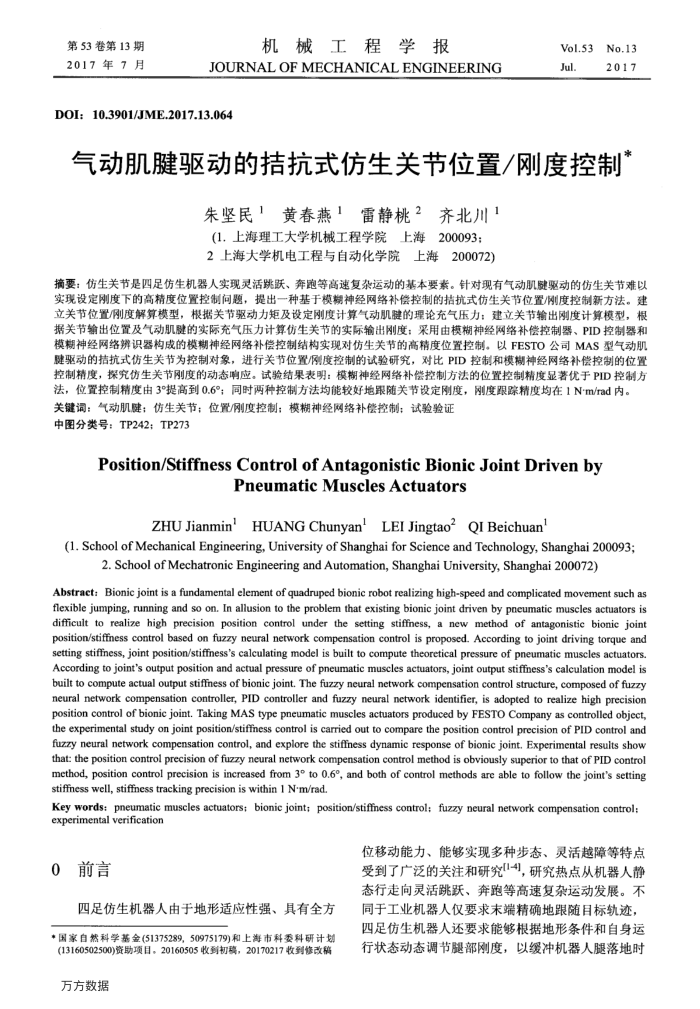气动肌腱驱动的拮抗式仿生关节位置∕刚度控制
内容简介
 第53卷第13期 2017年7月
第53卷第13期 2017年7月机械工程学报
JOURNAL OF MECHANICALENGINEERING
DOI:10.3901/JME.2017.13.064
Vol.53
No.13
Jul.
2017
气动肌腱驱动的拮抗式仿生关节位置/刚度控制
朱坚民黄春燕1雷静桃2齐北川1(1.上海理工大学机械工程学院上海200093: 2上海大学机电工程与自动化学院上海200072)
摘要:仿生关节是四足仿生机器人实现灵活跳跃、奔跑等高速复杂运动的基本要素。针对现有气动肌腱驱动的仿生关节难以实现设定刚度下的高精度位置控制间题,提出一种基于模糊神经网络补偿控制的拮抗式仿生关节位置/刚度控制新方法。建立关节位置/刚度解算模型,根据关节驱动力矩及设定刚度计算气动肌腱的理论充气压力:建立关节输出刚度计算模型,根据关节输出位置及气动肌腱的实际充气压力计算仿生关节的实际输出刚度:采用由模糊神经网络补偿控制器、PID控制器和模糊神经网络辨识器构成的模神经网络补偿控制结构实现对仿生关节的高精度位置控制。以FESTO公司MAS型气动肌腱驱动的拮抗式仿生关节为控制对象,进行关节位置/刚度控制的试验研究,对比PID控制和模糊神经网络补偿控制的位置控制精度,探究仿生关节刚度的动态响应。试验结果表明:模棚神经网络补偿控制方法的位置控制精度显著优于PID控制方法,位置控制精度由3°提高到0.6°;同时两种控制方法均能较好地跟随关节设定刚度,刚度跟踪精度均在1N-m/rad内。
关键词:气动肌腱;仿生关节;位置/刚度控制:模棚神经网络补偿控制;试验验证中图分类号:TP242;TP273
Position/StiffnessControlofAntagonisticBionicJointDrivenby
PneumaticMusclesActuators
ZHUJianmin'HUANGChunyan'LEIJingtao2
QIBeichuan
(1. School of Mechanical Engineering, University of Shanghai for Science and Technology, Shanghai 200093:
2.School of Mechatronic Engineering andAutomation, Shanghai University, Shanghai 200072)
seeaaaae flexible jumping, running and so on, In allusion to the problem that existing bionic joint driven by pneumatic muscles actuators is difficult to realize high precision position control under the setting stiffiness, a new method of antagonistic bionic joint position/stiffness control based on fuzzy neural network compensation control is proposed. According to joint driving torque and setting stiffness, joint position/stiffness's calculating model is built to compute theoretical pressure of pneumatic muscles actuators. According to joint's output position and actual pressure of pneumatic muscles actuators, joint output stiffness's calculation model is built to compute actual output stiffness of bionic joint. The fuzzy neural network compensation control structure, composed of fuzzy neural network compensation controller, PID controller and fuzzy neural network identifier, is adopted to realize high precision position control of bionic joint. Taking MAS type pneumatic muscles actuators produced by FESTO Company as controlled object, the experimental study on joint position/stiffness control is carried out to compare the position control precision of PID control and fuzzy neural network compensation control, and explore the stiffness dynamic response of bionic joint, Experimental resuits show that: the position control precision of fuzzy neural network compensation control method is obviously superior to that of PID control mcthod, position control precision is increased from 3° to 0.6°, and both of control methods are able to follow the joint's setting stiffiness well, stiffness tracking precision is within 1 N-m/rad.
Key words: pneumatic muscles actuators; bionic joint: position/stiffness control; fuzzy neural network compensation control: experimental verification
前言 0
四足仿生机器人由于地形适应性强、具有全方
*国家自然科学基金(51375289,50975179)和上海市科委科研计划(13160502500)资助项目,20160505收到初稿,20170217收到修改稿
万方数据
位移动能力、能够实现多种步态、灵活越障等特点受到了广泛的关注和研究(1-4],研究热点从机器人静态行走向灵活跳跃、奔跑等高速复杂运动发展。不同于工业机器人仅要求末端精确地跟随目标轨迹,四足仿生机器人还要求能够根据地形条件和自身运行状态动态调节腿部刚度,以缓冲机器人腿落地时
上一章:气动机械手轨迹的 Terminal 滑模控制方法
下一章:气动平衡器控制系统设计